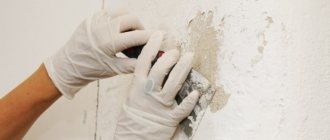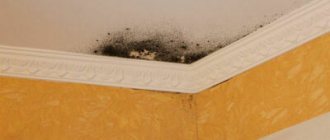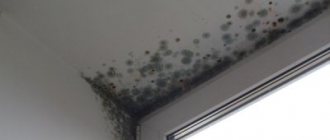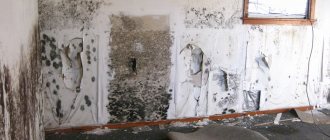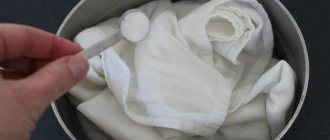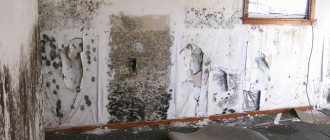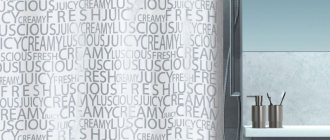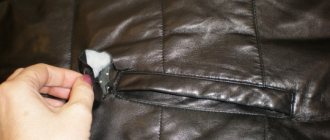Easy to appear, difficult to get rid of - the hallmark of black mold. This is a species of higher fungi of the mold family.
They live on the walls of residential and non-residential premises, in corners, at the joints of slabs. They pose a threat to life for humans and animals.
Provokes severe diseases of the lungs and bronchi. This is especially true for people with weakened immune systems, those prone to respiratory diseases, and children.
It reproduces by spores, by air, and is difficult to remove. How to remove mold? There are a number of methods that can cope with the problem, both in the initial stage and in advanced cases.
General concept of mold fungus
Mold - what is it and why does it grow on the wall?
Let me start with the fact that mold is everywhere - in the soil, on trees, in the air. Its spores were found at an altitude of 80 km from the ground. It is an extremely tenacious fungus with long branching filaments (hyphae) in gray, black, green or white. The most favorable climate for its destruction is a warm, humid place with poor air access.
One damp corner is enough to make you wonder how to remove mold from your apartment.
Reasons why fungus starts
Mold can appear in an apartment for the following reasons:
- Humidity 65% or higher. Sources may include leaks, poor ventilation in the kitchen, frequent drying of damp laundry, frequent and abundant spraying of flowers;
- Insufficient ventilation throughout the house. Stagnant air increases humidity and creates comfortable conditions for fungus;
- Uneven heating of walls. Especially in the fall, when heat has not yet reached the apartments and dampness is present everywhere: on the street, in the apartment.
- There is little benefit from rapid temperature changes. For example, when you are independent of central heating and have your own boiler, you should not get carried away with changing modes, or even turn off the heating altogether when leaving the house.
- The home gets cold and the same condensation forms under the ceiling due to the difference in climate inside and outside.
Favorite places for mold to grow in an apartment are the bathroom, corners, plastic windows, kitchen ceiling, tiles.
In private homes, you can add a cellar, wooden floors, and walls to this list. Mold also takes root well on concrete, plaster, linoleum, carpets, window frames and in washing machine drums.
How to usually remove mold yourself
You can fight the pest yourself. Before processing, it is necessary and mandatory to wear goggles, gloves, a mask or a respirator.
Spores entering the respiratory tract or mucous membranes can cause allergies, cough, conjunctivitis and a number of other chronic diseases. Therefore, it is worth protecting yourself.
Also be sure to remove animals, open windows and provide fresh air flow.
Several steps will be required:
- Make a bleach solution in a ratio of 1 part bleach powder or bleach to 3 parts water.
- Take a brush with elastic bristles, scrub the areas darkened by plaque, and remove the growths.
- Rinse well with water and wait until completely dry.
What to do to prevent mold
Once you have gotten rid of mold, you should maintain cleanliness and do constant preventative maintenance.
Important: use at least 2 permanent methods.
This way you will double the likelihood of success, because mold spores can remain inside a panel or brick wall for a long time.
What can be done for prevention?
- Check the serviceability of the ventilation system in the apartment, arrange ventilation;
- Carry out regular cleaning of “problem areas” with a soda or alcohol solution;
- Make sure that the bathroom and kitchen are as dry as possible;
- Dry things, towels and curtains in the bathroom thoroughly to avoid dampness;
- Replace pipes and other leaking plumbing fixtures in a timely manner;
- Buy special anti-fungal paint.
Tip: Consider installing an electric dehumidifier. It will relieve problems with dampness for a long time.
Don't be afraid of the fungus reappearing. You can handle it.
Compliance with safety regulations
Both mold and chemicals can be absorbed through the air into your respiratory tract. To prevent this from happening, you must follow safety rules. You should also not allow certain substances to come into contact with your skin, such as copper sulfate.
Safety regulations:
- Be sure to use rubber gloves to protect the skin of your hands and nails
- a mask, goggles and a respirator will protect the face and respiratory organs from harmful fumes of household chemicals and fungal spores that fly in the air
- a full-body robe or suit must be worn when treating surfaces at height, for example, when applying the product to the ceiling
Stages of mold control
Before joining the fight, think about why mold has started in this place and eliminate the root causes of the spread. This may be due to lack of ventilation, tightness of double-glazed windows, or, conversely, cracks in the wall.
Determining the sequence of steps
The general way to remove mold on the walls in an apartment will be like this:
- Analyze the extent of the fungal infestation;
- Look at the appearance of the surface. The processing method will depend on this;
- Choose the right product. Remember to protect your hands and airways so that particles do not get into them while you scrape or scrub the growth;
- Try to throw away everything that can be thrown away after getting rid of the fungus breeding ground;
- Follow preventative measures: ventilate, wash the walls, wipe the tiles dry, keep warm.
If it is not possible to remove mold from the wall in an apartment using home methods, they resort to the services of agencies that deal with this issue professionally.
Removing fungus and mold
Let's say you notice a small stain and rush to clean it. This will not stop there.
Just cleaning will not work to remove mold from the wallpaper in the apartment - the old covering will have to be removed.
And often the plaster underneath. Fungal spores penetrate deep into the wall and can grow again later.
Simply gluing new wallpaper will not help.
Arm yourself with gloves, a respiratory mask, a spatula, a sponge, hard sandpaper and an antiseptic solution such as fongifluid. First, peel off the paper completely. Scrape off the plaque along with the blackened pieces of plaster.
Tip: To prevent microparticles from flying around the room, moisten the wall.
Sand the affected areas well with sandpaper. After this, saturate the wall with an antibacterial agent (chemical, folk) to remove mold from the wall in the apartment. The surface treatment should be repeated 4-5 times, the walls should be thoroughly dried, primed, re-plastered and only then wallpaper should be glued.
To prevent mold from growing again in the future, arrange frequent (through) ventilation.
It is undesirable to place sofas, cabinets and other furniture close to damp walls - this causes the appearance of fungus and a musty smell.
Hint: The lack of air may be caused by an over-tight window.
Take care of this: open the vents and windows, install a valve for micro-ventilation. Errors during sewer installation or repairs also provoke the formation of mold under the wallpaper.
How to get rid of fungus on the wall
The appearance of mold stains on the walls can be caused by their freezing, internal leakage of pipes, or damp building materials. The lack of protective canopies from rain and gutters also creates conditions for the accumulation of moisture in the walls and the establishment of fungus.
How harmful is mold?
The accompanying problems caused by the appearance of mold concern not only the destruction of the home, but also affect human health. If the immune system is weakened and does not resist infections well, then microspores of the fungus can cause allergies, cough, and breathing problems. Once in the lungs, they cause bronchitis, rhinitis, and asthma. The skin is manifested by dermatitis, psoriasis, eczema, itching and other ailments. Small particles of mold enter the stomach along with food, and cause stomach pain, nausea, and poisoning. Carefully!
Black mold often contains toxins that are harmful to the body. With constant accumulation, the kidneys are most affected.
In addition, it spoils the appearance of the home, destroys walls, plumbing, and wood furniture.
Removing mold from the wall
Inspect the surface you will be working on. It happens that the fungus has “eaten” most of the wall and it needs to be dismantled. Wooden coverings are more often susceptible to this. If the outbreak is small and can be removed, then “fighting” is necessary. I will share the tips I received on how to remove mold from the wall of an apartment using folk remedies.
Copper sulfate helped me defeat fungus and black mold.
In Soviet times, this product was used to disinfect premises, and today it is successfully used to protect walls from mold deposits. Only 10 grams of powder is enough per liter of water.
Don't forget that vitriol is poisonous - wear rubber gloves and cover your face!
Just as in the case of wallpaper, it is better to moisten the walls so that the spores do not fly away and settle on other surfaces. Using a spatula or blunt knife, separate the growths from the wall. Spray the prepared solution on the infected areas or wet them with a sponge. Repeat the process 3 times during the day after each wall has dried. The final time, thoroughly wash everything with water and ventilate the apartment. After use, it is recommended to treat equipment with an antiseptic or throw it away.
Tip: a powerful hair dryer will help speed up the drying process.
You can buy vitriol in hardware stores; you need to use warm water - this way the sulfate dissolves faster. A spoon of vinegar will help make the product more powerful.
Aroma oils help a lot.
Monarda oil stops the growth of fungus, and tea tree oil copes with the first manifestations of plaque. Take the mixture:
- 2 ml oil
- 1 tsp coarse salt
- 100 ml water
Apply to the mold stain and leave. There is no need to rinse off the product.
Prevent reappearance
Look at the source of the congestion. If it spreads only in a certain place (under the sink, in the far corner), then the problem is poor ventilation; this area remains damp longer. Provide good ventilation and treat surfaces until the mold and odor disappear.
Think about why the mold appeared here and does not grow mold nearby.
You may need to adjust the heating, insulate the walls or improve the ventilation. Don't forget to fix leaks, cracks and crevices in window frames.
Radical method
This method is used for severe mold growth when other methods are powerless. The room is cleared of furniture and household items and processed completely, sequentially performing the following steps:
- First, the old coverings are removed - the ceiling, walls, and floor are left bare.
- The room is dried with a hair dryer.
- Dried surfaces are treated with a fungicidal substance.
- After drying, the procedure is repeated.
- The dry room is being renovated using antiseptic agents.
The labor-intensive procedure kills the mold forever.
Five effective remedies against mold
It happens that the ventilation works as it should, there is no freezing, the apartment does not smell damp, but fungus still appears. Most likely, this is a leak in the water pipes embedded in the wall. Only masters help here. And you can handle other cases yourself. To remove mold from the wall in an apartment using home remedies, we will need patience, perseverance and a couple of simple products:
Table vinegar
Proven budget method!
Wipe well or spray the wall with vinegar from a spray bottle, leave for a while, then wash thoroughly with water and make sure everything is dry. This is very important not only because of the vinegar smell: this way you will not create dampness;
Hydrogen peroxide
A familiar antibacterial agent. To remove mold from a wall in an apartment, you need to treat it with a 3% hydrogen peroxide solution. Peroxide copes well with bacteria, but once will not be enough - the procedure must be repeated until the stain completely disappears;
Soda
Kills the favorable environment for fungal growth. It is safe and does not have such a pronounced odor as vinegar. For the desired effect, 1 tablespoon per glass of water will be enough. An additional advantage of soda is that it is non-toxic and does not need to be re-treated with water;
Ammonia
Will help cope with mold on tiles, plastic, glass. It is diluted with water 1:1 and applied with a sponge, brush or microfiber cloth so as not to scratch the surface.
Don't forget to wear gloves so that the alcohol doesn't dry out your hands;
Bleach
Any one that you are used to using for laundry. This is more “heavy artillery”, less natural, but very effective (due to the alkali in the composition) for hard-to-reach places - far walls, pipes, baseboards. Dilute 1 capful of product in 500 ml of water and spray on the wall or tiles. After removing the fungus, thoroughly clean the entire room;
Remember: chlorine, peroxide and ammonia have bleaching properties.
Take this into account when processing different surfaces.
Varieties
There are more than one hundred thousand types of mold found in nature. Some of them are deadly, and some are used by humans for their own needs (for example, in the food industry or medicine).
influence on the human body, all the variety of types of mold can be divided into three main groups:
- Allergenic – contain allergens; this type of mold is especially dangerous for asthmatics.
- Pathogenic – cause various diseases; people with weak immunity are most susceptible to their effects.
- Toxic - the most dangerous, in the process of their life they release toxic substances that cause serious disorders in the body and can even lead to death.
By type, three main groups can be distinguished: black mold, white mold and fungi affecting wood.
Black mold:
Almost all fungi of this type are black. Most can be classified as a pathogenic group; this type is very dangerous. The most common types of this type:
- Ulocladium - can be found on almost any type of material: brick, concrete, wood, fabric, products.
- Alternaria is a commonly encountered fungus. Its food is fruits and vegetables, but it can also affect the respiratory organs of living beings.
- Aspergillus - most often found inside buildings. It has white reproductive organs and black spores. Causes the disease aspergillosis, which in rare cases leads to death.
- Penicillium - everyone has encountered this fungus; it has a significant role in medicine and the food industry. It is used to make antibiotics and blue cheeses. But some subspecies that can infect walls in apartments and houses are quite dangerous and cause a number of diseases.
- Wallemia is not a dangerous type of fungus, but it is quite tenacious and can withstand the tests of dry air and high temperatures.
- Cladosporium - can be not only black, but also any other color. He loves plants and seeds very much, but he also attacks other materials (even diesel fuel and fuels and lubricants, which is why it is called the “kerosene mushroom”).
- Chaetomium - can cause allergies, especially dangerous for the digestive system.
White Mold – This type of mold is less harmful than the ones described above. Found on the ground, wood, indoor plants, walls. Very often, white mold is confused with a white coating on the walls, called efflorescence.
Efflorescence is formed due to the leaching of salts from building materials; its structure has the form of crystals.
Fungi that attack wood:
- Often blue spots can be seen on new log houses or on wooden walls, floors, and ceilings. Especially if they are made of pine. This is a blue fungus that loves wood very much. In itself, it is not very dangerous, but it increases the susceptibility of wood to mold.
- Another type of wood disease is rotting fungi . When damaged, the tree cracks, splits, softens and rots into dust.
- The most terrible species is wood fungus . This is a very harmful wood-destroying mushroom. It settles on a felled tree and very quickly destroys the wooden structure.
How to soundproof walls in an apartment? Read in this article.
How to get rid of black
Of the 200 types of mold that exist, 20 grow in homes.
White mold looks like fluff.
It spreads very quickly throughout the apartment and is harmful to health. Therefore, you need to clean it off in full camouflage - a mask, gloves and closed clothing.
Green is the most common. This species is quite harmless and easy to deal with.
Dark green growths will require more effort, but are also not problematic. But black mold often contains toxic substances and can harm health and immunity. There is also a lot of hassle in the fight against it - strong drugs and frequent treatment will be required.
Why does black mold grow?
How to remove black mold in an apartment - the most tenacious and dangerous?
It will not be possible to completely get rid of the fungus unless the causes of its appearance are identified:
- Windows with increased tightness. The design prevents fresh air from entering the room;
- The apartment is located on the first or last floor. The basement may flood, the roof may leak. All this serves as a source of dampness, which the fungus loves;
- Residual moisture after repair. Do not open the windows, wait until the wallpaper is completely dry;
- Poor ventilation in the bathroom. Where it is both humid and warm. The fungus is a real haven here;
- Flowers or other plants on the windowsill.
Frequent spraying and watering contribute to high humidity in the home.
Additional reasons for the accumulation of moisture can be drying clothes, neighbors flooding from above, rotten internal pipes, and other various sources of moisture.
Removing black mold on your own
Be prepared for the fact that mold removal alone is not enough. Spores can “sit” inside walls for years, each time appearing on the surface under comfortable conditions. If a fungal colony has formed on the tiles in the bathroom, then it is easier to deal with it. Wash, clean and dry the tiles. Treat with soda or alcohol solution.
Don't forget about the seams between the tiles!
An old toothbrush will help you get there. Check ventilation and ensure wet areas in the bathroom are completely dry. And if black specks are visible on the walls, you will have to tinker. Table vinegar will help in treating mold. Apply the product generously to the infected area and leave for an hour. Just in case, spraying can be repeated again. After completing the work, wipe all surfaces with water and ventilate the apartment.
Ordinary “Whiteness” will also be a powerful assistant in this matter.
Wall decoration does not affect the appearance of fungus in any way; it will take root well on both wallpaper and drywall. But cleaning, cleaning, ventilation and cleanliness reduce the viability of spores.
What to do to prevent black mold from coming back again
Eliminating mold forever and preventing its reappearance in the future will require a competent approach. In order not to be afraid of the regular appearance of black fungus in your home, you should follow a number of simple rules:
- Set up a ventilation system in the bathroom and kitchen;
- When cooking, turn on the hood or open a window.
- Hot steam accumulates under the ceiling, on the wallpaper and can cause mold to form;
- Monitor the condition of plastic windows and adjust them for the winter;
- Do not get carried away with frequent spraying of flowers indoors;
- Fix leaks in a timely manner.
Prevention
Now let's find out how to protect your home from the recurrence of mold.
- The most common reason for the spread of mold is poor ventilation in rooms. Therefore, check the draft in your ventilation ducts with a lit match. If the match flame does not deviate towards the channel, there is no draft. To resolve this problem, you must contact your local utility service.
- Another reason for very poor ventilation is plastic windows with high tightness. By installing special ventilation valves on all windows, you will ensure a constant supply of new fresh air. Do not place furniture very close to wallpapered walls, since it is in closed areas that mold appears.
- To prevent mold from appearing under the wallpaper, ventilate the premises regularly. It is advisable to periodically open windows and vents in the house for certain periods of time. It is better to paint the jambs of window openings with special hydrophobic paints.
- Increased dampness of building materials, insufficient insulation between panels and other repair deficiencies can also cause the formation of fungus. Simple rain, which flows not through special gutters, but along the outside of the wall of the building, can lead to severe wetness. In these cases, be sure to demand that the housing organization eliminate such problems.
Mold in the apartment on different surfaces
How to remove mold from the ceiling in an apartment?
The appearance of plaque in such a place indicates leaking pipes or roofs, poor evaporation of moisture due to lack of air. Try rinsing the small fireplace well with laundry soap and drying it. But if the fungus has already grown, it is too late to do prevention. Corrective measures are needed. Put on a mask and goggles, wash off the whitewash, and remove the paint and plaster from the ceiling using a spatula. Saturate the joints and surface with a primer containing an antiseptic (this is convenient to do with a wide brush). When the primer is dry, apply a layer of putty. Prime again and dry.
Tip: Concrete and brick dry faster if you turn on a gas burner.
A wood ceiling will benefit from a heater or fan. The last step will be painting.
A secret that will benefit your budget: instead of an antiseptic, you can use ordinary “Whiteness”.
Simply painting a moldy ceiling will not solve the problem. The paint will kill the fungus on the outside, but not on the inside. And after a while he will appear again.
If there is mold in the corners
Before you remove mold in the corners of the apartment, look at exactly where it appeared. If the corner is formed by an external wall, it is necessary to insulate the home from the outside and seal the cracks under the windows. Regular rain can also be a cause. If the house does not have gutters and canopies, it makes the wall damp, and dampness is a good conductor of mold into the house.
Mold is always a result, not a cause.
An alcohol solution or vinegar will help remove the fungus. After impregnation, the corner must be dried thoroughly and a layer of fresh putty must be applied.
Hint: treat not only the infected area, but also the entire wall so that small particles do not “transplant” to another place.
It is better to carry out work in warm, dry weather.
Removing fungus from a wooden floor
Remove the top moldy layer of wood using a metal scraper or knife. Then sand the surface with stiff sandpaper. Prepare 2 or 3 antifungal agents and apply to the floor in turn after each drying.
For example: soda - chlorine.
If the area is large, repeat the treatment 7-10 times. After this, the floor can be covered with drying oil against parasites and painted.
Getting rid of white mold on the carpet
If it is possible to treat the carpet outside, do so so as not to spread harmful spores around the room during cleaning. If not, try covering the furniture. Turn on a bright light to ensure you don't miss a particularly tricky spot of mold. Use a firm brush to remove build-up from both sides of the carpet. Saturate the surface with an antiseptic.
I recommend peroxide: it does not “burn out” the color and does not leave a smell.
Dry and roll up the carpet and treat the floor. (2 – 3 times). Also remember to disinfect all tools. Try to warm and ventilate the area well for a week to get rid of any spores remaining in the air.
How to remove fungus from drywall yourself
All that remains is to find out how to remove mold from drywall.
Causes of mold on drywall include water leaks (you've been flooded), faulty ventilation, or leaking pipes.
Cleaning with a metal spatula, impregnation with an antiseptic solution, priming and painting will help deal with small spots. And if the mold is large and shaggy, then the sheet of drywall cannot be completely cleaned - it is better to replace it.
Rules for chemical processing
Strong fungicidal drugs are toxic. Therefore, before chemical treatment, cover the face with a mask or respirator, wear goggles and gloves.
Protect your face and hands when working
Prepare the tools:
- sharp construction spatulas;
- hard sponges and brushes;
- paint brushes;
- sprayer;
- roller;
- napkins.
Carefully read the instructions for the drugs, follow the algorithm of action and dosage. The coating is completely removed, after which they begin to destroy the fungus. Sometimes the fungicidal base has to be applied 2–3 times. The dried surface is treated with an antiseptic primer, plastered, and covered with a waterproofing mixture.
How and why to deal with mold odor
Removing a musty smell can be more difficult than the fungus itself. It spreads quickly, eats into walls, furniture, things and harms not only the home, but also the well-being of the residents. The smell has a particularly negative effect on children and the elderly.
How to remove the smell of mold in an apartment?
There are two options: to prevent the appearance or to fight an already existing fungus. In both cases, inspect the home and determine the source of the odor. Then dry the premises. Spraying a solution with tea tree oil, vinegar, or wiping surfaces with a soda solution will help quickly overcome the unpleasant aroma. For preventive purposes, you can use an aroma lamp with any citrus oils.
